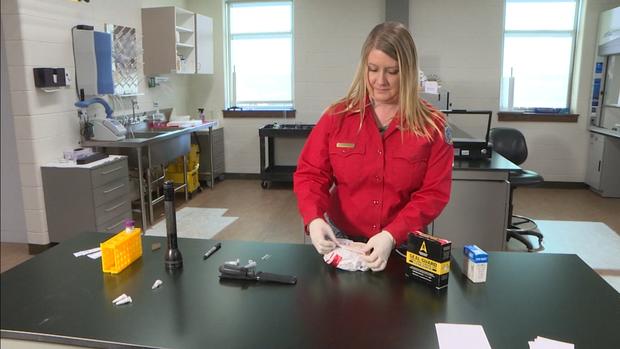'CSI Laramie Lab' Helps Colorado Wildlife Officers Solve Poaching Cases, Animal Attacks
LARAMIE, Wyo. (CBS4) - 130 miles north of Denver a team of forensic scientists in Wyoming are tasked throughout the year to help solve criminal cases in the State of Colorado. Investigations into poaching, trespassing and even predator attacks are solved largely due to the Wyoming Game and Fish Department's Wildlife Forensic Laboratory.
The state-of-the-art laboratory was built in Laramie in 2018. Serving 12 states, including Wyoming itself, the lab uses the latest technology to survey evidence collected by wildlife officers.
"Some people call us 'The CSI Laramie Lab,'" said Tasha Bauman, Forensic Program Manager for Wyoming Game and Fish. "Colorado is probably our number one state in the number of cases that are sent to us."
Bauman credited Colorado's booming population, mixed with easy access to the Rocky Mountains, for the high demand from the lab. She said most investigations involve elk, deer, bears and mountain lions.
"You do have the mountain range that holds those species. So, therefore you are going to see more potential poaching activity," Bauman told CBS4's Dillon Thomas.
Of those species, the majority of investigations involve elk and deer.
The lab was first created as part of a university study program. From there, the demand for investigating wildlife-related cases through DNA grew. Eventually, the lab was built to serve a significant portion of the central United States. From Louisiana to Minnesota and Illinois, the lab has a growing clientele.
Bauman said the lab needs very little evidence to paint a damning picture of a suspect for other states. The lab tried to connect a "triangle" for most investigations by linking a person to a crime scene, and the animal involved to the person. For example, Bauman said a single-strand of hair found on a knife in a home could link a suspect to blood at the scene of suspected poaching. From there, the DNA in a small swab of blood from the scene can easily be linked to the DNA found in the strand of hair from the knife.
"We are able to answer the question of what species (wildlife officers) are dealing with. And, what the gender is of the sample they are submitting," Bauman said.
The process is called Microsatellite Matching. The DNA samples are entered by computer to a machine. The machine then converts the samples to data drawn out into lines on a computer screen. From there, the lab workers can compare the wavelengths of each sample to see if they match in shape.
While the lab workers primarily work on cases involving the prosecution of humans, many times they also use their expertise to identify an animal in predator attack investigations. Recently, in Colorado, a mountain lion attacked a child. A DNA swab was taken from the puncture wounds of the child. Clothing was also collected in order to search for saliva and hair traces.
Bauman's team was able to positively identify the captured mountain lion by linking the animal's DNA to that which was found on the child.
"We are able to determine if the animal did the attack, or not," Bauman said.
Bauman said the work the lab is doing in Laramie is important, especially for the 11 states outside of Wyoming that rely on their services.
As someone who initially went to college to become a physical therapist, Bauman said the rewards of the work she does everyday is what keeps her so interested in the lab.
"It is actually pretty exciting when you see that the DNA work we are doing here helped a wildlife officer make their case stronger through the court system," Bauman said.
The Wildlife Forensic Lab is currently in the process of negotiating working relationships with at least two more states.





